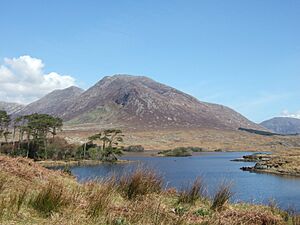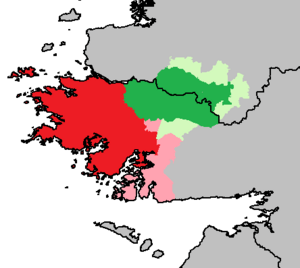Connemara facts for kids

Connemara (coneh-mar-a) (Irish: Conamara) is a special part of Ireland located on the Atlantic coast in western County Galway. It's known for its strong connection to traditional Irish culture. Many people here speak Irish, making it the largest "Gaeltacht" (Irish-speaking area) in the country.
Connemara is a beautiful place with lots of mountains, like the famous Twelve Bens. It also has many peninsulas (land surrounded by water on three sides), small bays, islands, and lakes. The Connemara National Park is in the northwest, offering amazing scenery. It's mostly a rural area, meaning it has more countryside than cities. The biggest town in Connemara is Clifden.
Contents
- What is Connemara?
- Where did the name Connemara come from?
- Exploring Connemara's Geography
- A Look at Connemara's History
- Getting Around Connemara
- The Irish Language in Connemara
- Famous People from Connemara
- Important Islands of Connemara
- Other Cool Things Named After Connemara
- Images for kids
- See also
What is Connemara?
The name "Connemara" usually refers to the northern part of County Galway, west of Lough Corrib. It's also used to describe the Gaeltacht areas (places where Irish is spoken) in western County Galway.
Where did the name Connemara come from?
The name "Connemara" comes from an old tribal name, Conmacne Mara. This group was part of a larger tribe called the Conmacne. Since this specific group lived by the sea, they were called the Conmacne Mara. In Irish, "muir" means sea, and "mara" means "of the sea."
Exploring Connemara's Geography
Connemara's coastline has many peninsulas. For example, Iorras Ainbhtheach in the south is the largest, with villages like Carna and Kilkieran. Other peninsulas include Errismore, Errisbeg, Errislannan, Kingstown, Coolacloy, Aughrus, Cleggan, and Renvyle.
There are also many islands off the coast. Inishbofin is the biggest. Other islands include Omey, Inishark, High Island, Friars Island, Feenish, and Maínis.
Connemara is part of a larger historical area called Iar Connacht, which means "West Connacht." This is the part of County Galway that lies west of Lough Corrib. Connemara was traditionally split into North and South Connemara. The Twelve Bens mountains and the Owenglin River (which flows into the sea at Clifden) formed the border between these two parts.
The Atlantic Ocean borders Connemara on its west, south, and north sides. The land border with the rest of County Galway is marked by the Invermore River, Oorid Lough, and the western part of the Maumturks mountains.
A Look at Connemara's History
The Ó Cadhla clan ruled Connemara until the 1200s. Then, the Ó Flaithbertaighs took over. They had moved into Iar Connacht after the English invaded Connacht in the early 13th century. The Mac Conghaile (Conneely) clan was also an important group in Connemara.
Clifden is the main town in Connemara. The area around Clifden has many ancient stone tombs called megalithic tombs.
A special type of stone called "Connemara Green marble" is found here. This beautiful green marble was used by people long ago and is still very valuable today. It's used for large building parts and even small pieces of jewelry. It's also used for the pendant of the Scouting Ireland Chief Scout's Award, which is the highest award in Irish Scouting.
In 1919, the first flight across the Atlantic Ocean, flown by Alcock and Brown, landed in Clifden. This was a huge moment in history!
Getting Around Connemara
You can get to Connemara by bus using Bus Éireann and City Link services. Long ago, from 1895 to 1935, there was a train line that connected Galway to Clifden.
The N59 is the main road through the area, going inland from Galway to Clifden. Many people also enjoy the coastal route, which starts with the R336 from Galway. This route is known as the Connemara Loop and is a 45 km drive with amazing views of the landscape.
Aer Arann Islands offers flights to the Aran Islands from Connemara Airport (also called Aerfort na Minna) in the south of Connemara.
The Irish Language in Connemara
Connemara has about 32,000 people. A large number of them, between 20,000 and 24,000, are native Irish speakers. This makes Connemara the largest Irish-speaking Gaeltacht in Ireland.
Many of the areas with the highest percentage of Irish speakers in all of Ireland are found in South Connemara. Most of the Irish speakers are school-aged children and teenagers (5–19 years old).
Famous People from Connemara
Connemara has been home to many interesting people:
- Éamon a Búrc was a legendary Seanchai (traditional Irish storyteller). His amazing tales were recorded by the Irish Folklore Commission.
- Nan Tom Teaimín de Búrca and Róisín Elsafty are well-known sean-nós singers, which is a unique style of traditional Irish singing.
- John Ford, a famous American film director who won 4 Academy Awards, had family roots in An Spidéal. He directed the classic movie The Quiet Man nearby.
- Joe Heaney (1919–1984) was another legendary Seanchai and sean-nós singer from Carna. He was said to know over 500 songs! A festival is held every year in Carna to remember him.
- J. Bruce Ismay was the chairman of the White Star Line, which owned the Titanic. He lived in Connemara for part of his later life and was a survivor of the Titanic sinking.
- Seán Mannion was a professional boxer who fought for the WBA title. He was born in Rosmuc.
- Peter O'Toole, the famous actor known for his role in Lawrence of Arabia, was born in Connemara in 1932, according to some stories.
- Tim Robinson is a cartographer (mapmaker) who lived in Connemara for many years and wrote books about the area.
- Gráinne Seoige and Síle Seoige are well-known Irish TV presenters and journalists, both from An Spidéal.
- Mairtin Thornton was a heavyweight boxer, nicknamed the "Connemara Crusher." He was the Irish Heavyweight boxing champion in 1943.
Important Islands of Connemara
- Omey Island (Iomaidh)
- Inishbofin (Inis Bó Finne) has a long history, being home to fishermen, farmers, monks, and even pirates for over 6,000 years! Today, about 200 people live there full-time.
Other Cool Things Named After Connemara
- The French singer Michel Sardou had a popular song called "Les Lacs du Connemara" in 1981.
- There's a well-known Irish drinking song called "The Hills of Connemara."
- The home of poet Carl Sandburg in North Carolina, which is now a national monument, is named after Connemara.
- There's even a region of "chaotic terrain" on Jupiter's moon Europa called Conamara Chaos!
- The Connemara pony is a strong and beautiful breed of horse that comes from this region.
- "Connemara" is also the name of a type of Irish whiskey made at the Cooley Distillery.
Images for kids
-
A memorial to Irish language writer Máirtín Ó Cadhain at Dublin Airport.
See also
 In Spanish: Connemara para niños
In Spanish: Connemara para niños





